The Impact of Owls on Woodpecker Populations
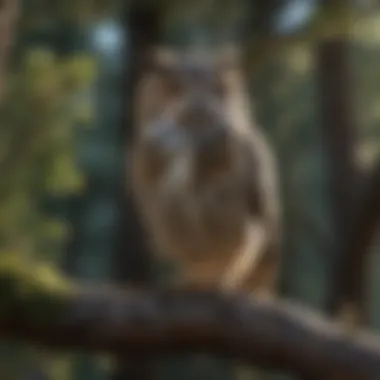
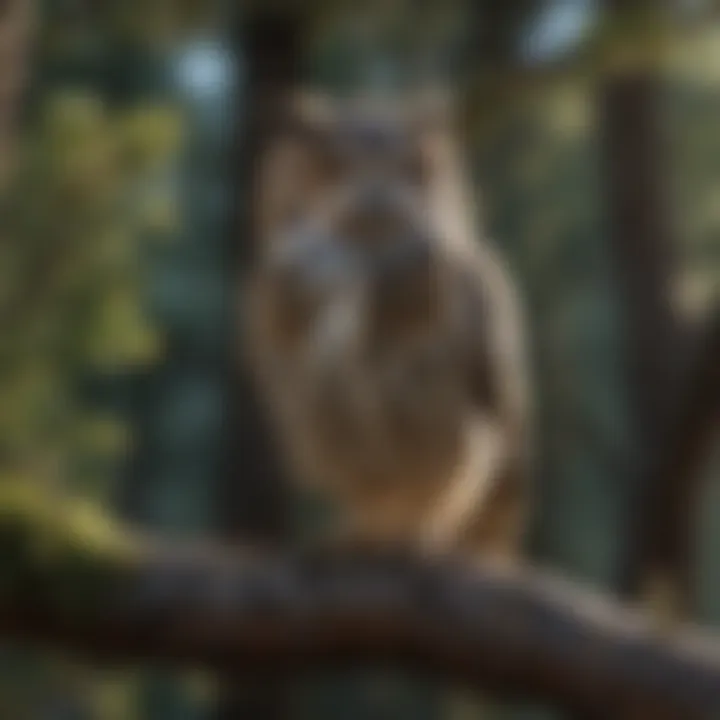
Intro
Understanding the interactions between different species in an ecosystem is crucial for maintaining biodiversity. One such interaction that deserves attention is the relationship between owls and woodpeckers. This article examines how the presence of owls influences woodpecker populations, providing insight into the ecological roles both birds play. Through an exploration of behavioral patterns and predator-prey dynamics, we can see the significant implications these interactions have on pest management and overall ecological balance.
Understanding the Dynamics
Understanding the dynamics of predator and prey helps clarify the complexities of these bird populations. Owls, as nocturnal predators, have unique behaviors that can impact woodpecker numbers. Woodpeckers, in contrast, exhibit specific habits that may affect how they interact with their environment.
Owl Behavior and Role in Ecosystem
Owls prefer wooded areas and regions with abundant prey. Their diet primarily consists of small mammals, insects and at times, birds, including woodpeckers. While they serve as predators, their presence can modulate the activity levels of woodpeckers, particularly during nesting seasons.
Woodpecker Habits and Ecology
Woodpeckers inhabit various forest types. They are cavity-nesters and feed on insects within trees. Their foraging habits and ability to drill holes impact the tree health. Their interactions with trees also benefit other species, highlighting their role in the ecosystem. When owls are present, woodpeckers may alter their behavior by becoming more cautious, especially when foraging or during breeding.
Implications for Woodpecker Populations
The presence of owls can have a dual effect on woodpecker populations. While owls can reduce woodpecker numbers through predation, they also contribute to a healthier ecosystem overall. By keeping woodpecker populations in check, owls help maintain balance within the forest ecosystem.
Owls are not just predators; they are essential for regulating populations in their habitats.
Benefits of Owl Presence
- Population Control: By preying on weaker individuals, owls can promote genetic health within the woodpecker population.
- Behavioral Changes: The presence of owls may lead woodpeckers to be more vigilant, encouraging adaptability and enhancing survival strategies.
- Supporting Biodiversity: A balanced predator-prey relationship fosters diverse ecosystems, allowing other species to thrive.
Challenges
- Over-Predation: In certain conditions, excessive predation can lead to local declines in woodpecker numbers.
- Habitat Loss: Changes in habitat due to human activities can further stress woodpecker populations, making them more vulnerable to predators like owls.
Ending
The relationship between owls and woodpeckers highlights a delicate balance in nature. By understanding these interactions, we can better appreciate the roles both birds play in their ecosystems. It is vital to consider how such dynamics affect pest management strategies and ecological health in various environments.
Preface to the Owl-Woodpecker Relationship
The relationship between owls and woodpeckers is an essential topic for understanding ecological balance in various habitats. These two bird species interact in ways that have significant implications for the populations of each. This article explores the dynamics of their relationship, emphasizing how the presence of owls can influence woodpecker populations.
Owls are known for being at the top of the food chain in their ecosystems. As predators, they have a direct impact on the species they hunt, including woodpeckers. Understanding this relationship can reveal much about the health of ecosystems and their biodiversity. By examining the behaviors of both owls and woodpeckers, we gain insights into broader ecological roles.
Regarding the benefits, understanding the interaction between these birds aids in wildlife management practices. Effective management strategies can ensure that both species thrive, enabling them to contribute positively to their habitats.
Defining the Species
To comprehend the dynamics between owls and woodpeckers, it is important to define these species clearly. Owls belong to the order Strigiformes, encompassing various species such as the Great Horned Owl and Eastern Screech Owl. These birds are known for their nocturnal habits, silent flight, and acute hearing.
Woodpeckers, on the other hand, belong to the family Picidae. They includes species like the Downy Woodpecker and the Pileated Woodpecker. Woodpeckers are commonly recognized for their foraging behavior on trees and their distinctive pecking sounds. The differences in their habitats, feeding strategies, and social structures set the foundation for their interactions.
Understanding their Ecological Roles
Both owls and woodpeckers play crucial roles in their ecosystems. Owls serve as vital indicators of ecosystem health. As top predators, their presence can signify a balanced food web. They help regulate populations of small mammals and other birds, contributing to the stability of their habitats.
Woodpeckers, conversely, are primary excavators of tree bark. Their foraging behavior creates habitats for other species. By drilling into trees, they access insects, also providing nesting sites for other birds and mammals. Their role in the decomposition process is essential, as it aids in nutrient cycling within forests.
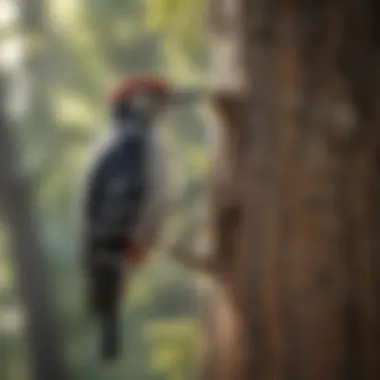
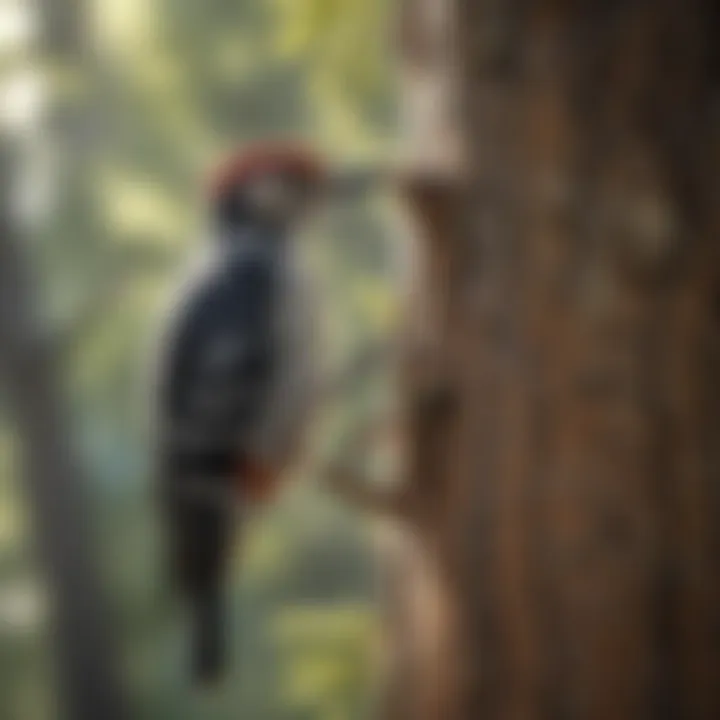
In summary, the interplay between owls and woodpeckers offers a window into ecological dynamics. Recognizing their roles aids in comprehending the delicate balance of nature. Overall, this introduction sets the stage for a deeper exploration of their interactions and influences.
Behavior of Owls and Woodpeckers
The behavior of owls and woodpeckers is a topic that provides valuable insights into the dynamics of predator-prey interactions in ecosystems. Understanding how these two bird species behave in relation to each other reveals aspects of their ecological functions and adaptations. This section will enumerate how the hunting strategies of owls and the defense mechanisms of woodpeckers interact to influence woodpecker populations.
Owl Hunting Strategies
Owls are predominantly nocturnal hunters, adept at detecting and capturing prey in low light conditions. Their hunting strategies vary across species, but some common characteristics define their success:
- Silent Flight: Owls possess specialized feathers that allow for quiet flight. This adaptation helps them approach prey unnoticed.
- Acute Hearing: Their ability to locate prey using sound is exceptional, allowing them to hunt effectively even in dense habitats.
- Stalking and Ambushing: Many owls will remain still and blend into their surroundings until the right moment to attack. This method is particularly effective against unsuspecting woodpeckers.
Through these strategies, owls can impact woodpecker populations directly. For example, during certain seasons when food is scarce, woodpeckers might be more vulnerable to owl predation.
Woodpecker Defense Mechanisms
Woodpeckers have evolved various defense mechanisms to counteract threats, including those posed by owls:
- Vigilance and Alarm Calls: Woodpeckers are attentive to their surroundings. They communicate warning calls to alert other woodpeckers of an owl’s presence.
- Flocking Behavior: They often travel in small groups. This group living strategy can enhance protection as more eyes are on the lookout for predators.
- Rapid Flight: When challenged, woodpeckers can perform quick, erratic flights. This speed, combined with the ability to navigate through trees, helps them escape from pursuing owls.
- Choosing Nest Sites: Woodpeckers select nesting sites that are harder for owls to access. Higher locations or dense foliage can provide added safety.
In summary, the behaviors of owls significantly shape the adaptations of woodpeckers. Their hunting strategies compel woodpeckers to refine their defense mechanisms. This ongoing interaction contributes to the dynamics of their populations and influences the overall health of their ecosystems.
Predator-Prey Dynamics
Understanding predator-prey dynamics is crucial in the study of the interaction between owls and woodpeckers. This topic illustrates the delicate balance that exists in ecosystems where these two birds coexist. The dynamics between owls, apex predators, and woodpeckers, typically situated lower on the food chain, highlight important ecological principles, including population regulation, resource allocation, and adaptability of species.
Owls serve as significant predators, influencing the population sizes of various bird species, including woodpeckers. The presence of owls can lead to a reduction in woodpecker numbers, altering their behaviors and habitats. This relationship serves as an example of how predator presence affects prey populations, which is critical for anyone interested in the broader ecological interactions of birds.
Key elements to consider regarding predator-prey dynamics include the following:
- Impact on Woodpecker Numbers: As owls hunt woodpeckers, there is a direct relationship regarding how many woodpeckers can survive and reproduce.
- Behavioral Changes: The need to avoid predation can lead woodpeckers to change their feeding and nesting habits, potentially decreasing their access to resources.
- Population Regulation: Owls may help maintain a balance in woodpecker populations, preventing overpopulation which can lead to a depletion of resources.
"The predator-prey relationship is not just one of survival, but one that shapes the behavior and evolution of species within their environment."
Interactions Between Species
The interactions between owls and woodpeckers are complex. For instance, owls tend to hunt at night, while woodpeckers are more active during the day. This temporal separation can minimize direct encounters, but owls are known to employ various hunting strategies that make them adaptable predators. When assessing how these birds interact, it is essential to look at shared habitats, feeding habits, and their respective roles in the ecosystem.
Owls utilize their keen eyesight and hearing to locate prey in various environments that overlap with woodpecker territories. Frequently, owls will sit quietly and wait for woodpeckers to come within striking distance. Such predatory behavior urges woodpeckers to heighten their vigilance. Socially, woodpeckers often live in groups, which can offer some safety in numbers against predation.
Impact of Habitat on Behavior
Habitat plays a pivotal role in the relationship between owls and woodpeckers. Different types of woodlands, urban areas, and forest environments provide varying levels of resources for both birds. Dense forests may protect woodpeckers by providing plenty of hiding spots, making it challenging for owls to hunt effectively. Conversely, in open or fragmented habitats, woodpeckers may become more vulnerable to owl predation, leading to higher mortality rates.
The type of habitat can determine the abundance of both owls and woodpeckers. For instance:
- Old Growth Forests: These environments typically support a rich diversity of wildlife, which may lead to more stable woodpecker populations despite the presence of predators like owls.
- Urban Areas: In cities, the reduced availability of natural nesting sites may pressure woodpecker populations, especially when competing against predation.
- Mixed Habitats: Areas with both open spaces and dense Canopy can lead to shifts in owl hunting strategies, influencing woodpecker behaviors and survival.
Overall, examining the predator-prey dynamic between owls and woodpeckers reveals deep ecological truths that are critical for maintaining the stability of their habitats and coexistence.
Owls as Natural Pest Controllers
Owls hold an important role in the ecological balance as natural pest controllers. Their presence in various environments can influence the populations of several creatures, including rodents and insects, which can indirectly impact woodpecker populations. Understanding this relationship is essential for recognizing owls as a helpful element in pest management and ecosystem health.
Benefits of Owl Habitats
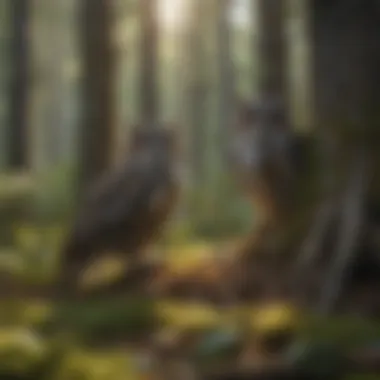

Owl habitats often coincide with the environments where woodpeckers thrive. These habitats can range from mature forests to open lands with scattered trees. They provide cover and nesting sites for owls while also supporting a variety of prey species. The benefits of well-maintained owl habitats include:
- Reduction of Rodent Populations: Owls are skilled hunters of small mammals, notably rodents. Their hunting helps control these populations, lessening competition and disease spread.
- Regulation of Insect Numbers: Many owls also consume insects. By controlling insect populations, they mitigate the damage these pests may inflict on trees, thereby protecting the food sources of woodpeckers.
- Creating Balanced Ecosystems: Healthy owl populations result in a more stable ecosystem. This balance benefits woodpeckers that rely on ample food and nesting resources.
Role in Ecosystem Management
Owls contribute significantly to ecosystem management in several ways. Their dietary habits help maintain species diversity by regulating prey populations. Furthermore, they serve as indicators of ecological health. The following points outline their roles:
- Predator-Prey Interactions: By preying on specific species, owls stabilize ecosystem dynamics. This prevents certain species from becoming overly dominant while ensuring that woodpeckers have access to abundant resources.
- Biodiversity Enhancement: Healthy owl populations can support a variety of other bird species, including woodpeckers. Diverse ecosystems are more resilient and capable of withstanding environmental changes.
"Owls are not just predators; they are essential architects of their environments. Without their natural pest control, ecosystem balance will be disturbed."
Owls as natural pest controllers play a critical role in maintaining the balance that directly or indirectly affects woodpecker populations. Their habitats and ecological functions are vital for promoting diverse and healthy ecosystems.
Through conservation efforts focused on owl habitats, individuals can contribute to the interplay between these impressive creatures and woodpecker communities, ensuring both flourish in their environments.
Conflict and Coexistence
The relationship between owls and woodpeckers presents an interesting case of conflict and coexistence. Understanding this dynamic is crucial, as it reveals how two different bird species manage to share the same habitat while vying for similar resources. This section examines the consequences of their interactions and how they influence woodpecker populations.
Competition for Resources
Owls and woodpeckers exist in overlapping ecosystems, which leads to direct competition for resources such as food and nesting sites. Woodpeckers primarily feed on insects found in trees, while owls may also hunt similar prey. This results in a struggle for food during certain seasons, particularly when resources are limited.
Factors such as habitat destruction and environmental changes worsen this competition. As trees are cut down or ecosystems altered, both species may find themselves competing more fiercely for the resources that remain.
"Competition shapes the behavior and populations of birds more than many appreciate."
Moreover, woodpeckers have to expend energy to avoid predation by owls. The presence of owls in their vicinity may lead to heightened vigilance among woodpecker populations. This change in behavior can affect the foraging efficiency of woodpeckers. As they become more cautious, their ability to gather food diminishes, which can lead to lower reproductive success.
Space and Nesting Preferences
Space is another critical factor in the interactions between owls and woodpeckers. Owls often prefer to nest in old trees with ample cavities, similar to the habitats favored by woodpeckers. When both species inhabit the same area, the potential for conflict increases, especially during nesting seasons.
Woodpeckers rely on dead or decaying trees for nesting, which may overlap with the nesting sites of certain owl species. If owls occupy these cavities, the woodpeckers may have to relocate or delay nesting, which can hinder their reproductive success. Choices regarding nesting height and site can also be affected by the presence of owls.
In some cases, woodpeckers may adapt by changing their nesting habits to avoid encountering owls. This dynamic between competition and adaptation highlights the nuanced ways that the two species influence each other. Understanding these interactions is vital in managing their habitats and ensuring the balance of both populations in shared ecosystems.
Influence of Owl Populations on Woodpecker Behavior
The interaction between owl populations and woodpecker behavior is a significant area of study in ornithology. Understanding this relationship sheds light on predator-prey dynamics and how these two bird species influence each other within their ecosystems. The presence of owls likely alters the behavior patterns of woodpeckers, affecting their survival and reproductive strategies.
Behavioral adaptations of woodpeckers to the presence of owls are crucial for their survival. As nocturnal predators, owls pose a constant threat to woodpeckers, which are primarily active during the day. Therefore, woodpeckers may develop certain behaviors to avoid encounters with owls. These adaptations are essential components that ensure woodpeckers can continue to thrive despite the risks posed by these predators.
Changes in activity patterns also play a vital role in understanding the influence of owls on woodpecker populations. Woodpeckers may modify their feeding and nesting behaviors based on the activities of owls nearby. For instance, they might become more vigilant and avoid foraging in open areas where they can be easily spotted by an owl.
In this increasing awareness of environmental threats, woodpeckers can also change their nesting preferences. By selecting locations that are less accessible to owls, woodpeckers may enhance their chances of successfully raising offspring.
The impact of owl populations on woodpecker behavior is not merely a matter of survival; it extends into broader ecological implications. The delicate balance between these species helps maintain the diversity and health of their habitats.
"Understanding these interactions is crucial for effective habitat management and conservation efforts."
In summary, the relationship between owls and woodpeckers exemplifies the complexity of ecological interactions. Analyzing both behavioral adaptations and changes in activity patterns provides insight into how these birds coexist and adapt. Ultimately, these dynamics are essential for maintaining ecological balance, influencing not just the two species but also the overall health of their environment.
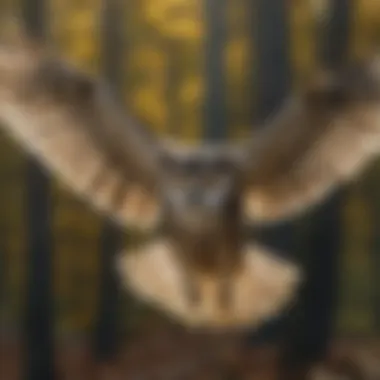
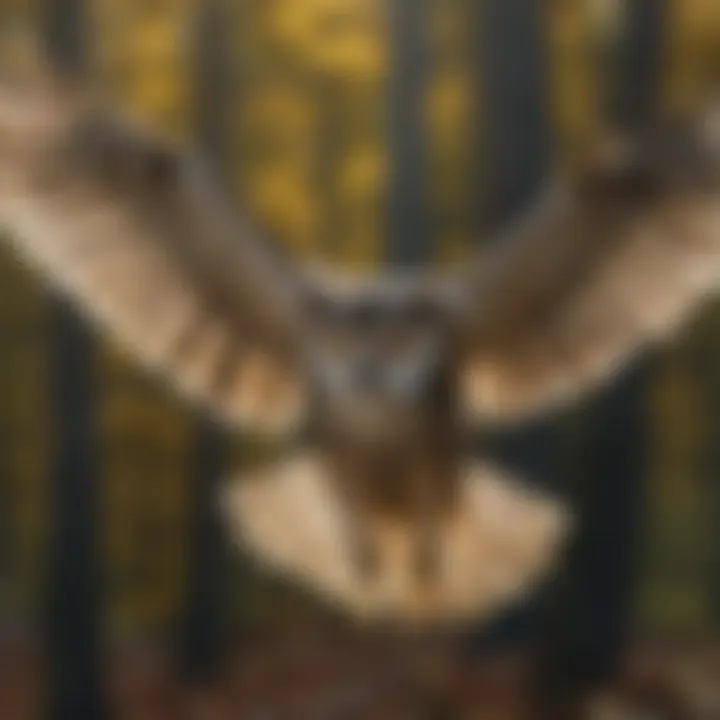
Evidential Studies on Bird Interactions
Understanding the interactions between owls and woodpeckers requires comprehensive examination through evidential studies. These studies offer valuable insights into behaviors, population dynamics, and ecological impacts that are not immediately observable in natural settings. By systematically analyzing these bird species' behaviors and adaptations, researchers provide a clearer picture of how these two avian groups influence each other. Consequently, this section will highlight the importance of field observations and experimental research in shedding light on owl-woodpecker interactions.
Field Observations
Field observations are crucial in studying birds in their natural habitats. Observers note owls' hunting practices and how these affect woodpecker populations. Regular monitoring allows researchers to see seasonal changes in behavior and population density. For example, during certain seasons, the presence of owls may deter woodpeckers from foraging in open areas. Observational studies also document factors such as food availability and nesting habits which are integral to understanding species interactions.
Key benefits of field observations include:
- Direct insight: Researchers can see real-time interactions, rather than relying on theoretical models.
- Detailed behavioral understanding: It offers a comprehensive look at each species’ reactions to the other.
- Longitudinal data: Over time, patterns emerge that can forecast changes in populations.
Additionally, these observations often involve citizen scientists, which enhances data collection and public engagement with ornithology. A divide between academic and citizen observation diminishes, allowing for more substantial findings.
Experimental Research
Experimental research adds another layer of understanding to the owl-woodpecker dynamic. Experiments are typically designed to test specific hypotheses about behaviors or ecological impacts under controlled conditions. For instance, experiments can measure how woodpecker stress levels change in locations where owl calls are played. This type of research helps to clarify how the fear of predation shifts woodpecker behavior in environments frequented by owls.
In experimental design, considerations must be made for:
- Controlled Variables: Minimizing outside influences ensures accurate results.
- Recreations of natural settings: Effective experiments require replicating conditions as they are in the wild.
- Statistical Analysis: It is essential to interpret the data correctly and understand significance in results.
Experimental studies have revealed measurable impacts on woodpecker behavior. For example, in environments where owls are present, woodpecker nesting choices and foraging times change significantly. By understanding these dynamics, researchers can determine optimal strategies for managing bird populations and preserving ecological balance.
"Understanding these relationships helps in conservation efforts and informs pest management strategies across diverse ecosystems."
Ultimately, combining field observations with experimental research provides a comprehensive approach to studying owls and woodpeckers. The insights garnered from these studies highlight the complexities of their interactions. Understanding the nuances in their relationship not only adds to scientific literature but also benefits those interested in wildlife management and conservation.
Implications for Pest Management
The relationship between owls and woodpeckers extends beyond mere predation and competition; it offers significant insights into pest management strategies. Owls, as natural predators, can influence woodpecker populations and their behaviors. Understanding this dynamic can lead to effective pest control solutions in various habitats.
Owls help manage pest populations by controlling the number of woodpeckers, which sometimes cause harm to trees. In areas where woodpeckers proliferate excessively, they can damage trees through their drilling for insects. This can lead to a cascading effect in the ecosystem, as weakened trees become susceptible to further pest infestations. Thus, owls may serve as a biological control mechanism by keeping woodpecker numbers in check. The implications of this relationship are far-reaching for homeowners and landowners alike.
"Biological pest control, through natural predator-prey relationships, can reduce the need for chemical interventions, supporting healthier ecosystems."
Integrated Pest Management Strategies
Implementing Integrated Pest Management (IPM) strategies is fundamental. This approach combines different management methods and practices to control pest populations in an eco-friendly way. Here are some crucial elements of integrating owls into pest management:
- Habitat Conservation: Protecting and enhancing habitats for owls can benefit overall biodiversity. A diverse ecosystem maintains balanced predator-prey interactions.
- Monitoring Populations: Regularly monitoring woodpecker populations can help determine if owl presence is effectively controlling numbers. Understanding dynamics is key to refining management strategies.
- Adopting No-Till Practices: Reducing soil disturbance can help maintain insect populations that serve as food for both owls and woodpeckers, supporting a balanced ecosystem.
- Community Involvement: Encouraging local communities to embrace owl-friendly practices, like creating nesting sites, can enhance natural pest control efforts.
Promoting Owl Habitats for Pest Control
Promoting habitats that support owl populations is a significant step in effective pest management. Here are tactics to encourage owl presence:
- Nest Boxes: Installing owl nest boxes can help establish stable breeding populations in residential areas. This ensures a consistent presence of these birds, contributing to pest control.
- Planting Native Trees: Creating landscapes with native vegetation can provide food sources and shelter for owls. They often prey on small mammals and birds, further aiding in pest management.
- Minimizing Chemical Use: Reducing the use of pesticides not only benefits owls but also contributes to a healthier environment for woodpeckers and other wildlife.
These methods can enhance the ecological health of an area, helping maintain a balance between owls and woodpeckers. Overall, the implications for pest management underscore the importance of understanding these avian relationships. By fostering owl habitats and using integrated strategies, landowners can effectively manage both owl and woodpecker populations while supporting broader ecological sustainability.
Epilogue
The examination of the relationship between owls and woodpeckers reveals significant insights relevant to ecological balance. Owls, as apex predators, undoubtedly affect woodpecker populations. Understanding these dynamics is crucial for both conservation efforts and pest management.
Summarizing the Findings
In summary, this article discusses several key points about the interactions between owls and woodpeckers. Firstly, the behavioral adaptations of woodpeckers in response to the presence of owls indicate a direct connection. This adaptation manifests in changes in nesting habits or daily activity patterns, ultimately determining their survival rates. Furthermore, our exploration highlights how owls function as natural pest controllers, indirectly influencing woodpecker populations through selective predation. The ecological roles of both species demonstrate their importance, underscoring their shared habitats and resource utilization.
Future Research Directions
Future research could take various forms to deepen the understanding of this relationship. One potential avenue involves long-term field studies focusing on the effects of varying owl populations on woodpecker behavior over multiple seasons. Other studies might examine how specific owl species, such as the Great Horned Owl, impact different woodpecker species. Additionally, the integration of technological tools for tracking both birds could yield insightful data on their interactions. Collaborations with conservation groups may amplify these efforts, potentially leading to more effective habitat management practices. Such studies would enhance knowledge not only about owls and woodpeckers but also the broader ecosystems in which they live.







